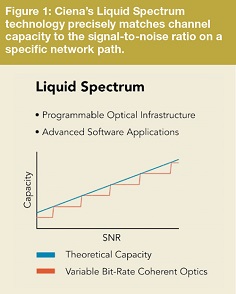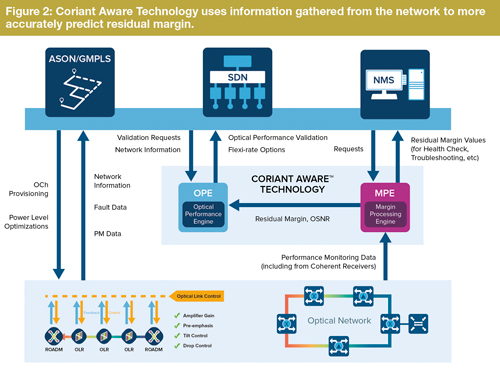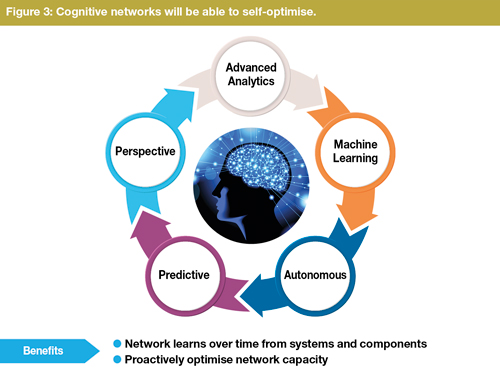Optical networking is becoming smarter. Guesstimates and offline calculations are on their way out; to be replaced by real-time computation and machine learning applied to ‘big data’ generated by the network itself, which can be used to optimise performance in ways that weren’t possible before.
The standard process for commissioning optical links relies on designing the system with adequate ‘margin’ so that it will continue to operate under worst-case scenarios. System margin is set to ensure that variations in the system operating parameters do not result in an unacceptable decrease in system performance. But as the amount of data traffic carried on optical networks continues to spiral upwards, operators want to squeeze those margins. They simply can’t afford to waste bandwidth.
Finding ingenious, software-driven methods to improve the performance of optical hardware was one of the hottest topics at the Optical Fiber Communication conference and exposition (OFC 2017) held in Los Angeles in March. Several new margin-squeezing technologies were unveiled at the show: Ciena announced a software automation portfolio under the name ‘Liquid Spectrum’ while Coriant’s contribution to performance optimisation is called ‘Coriant Aware Technology’.
Also, in a Sunday workshop researchers and executives from academia and the industry explored the question: will machine learning and big data analytics relieve the optical industry from the complexity of system and network engineering? (Spoiler: yes, undoubtedly). Such technologies are still in their infancy, but can be expected to have a profound effect on the optical networking industry in the future.
Meanwhile, Infinera has unveiled its ‘Instant Network’ concept, which will enable its customers to automate the process of setting up and tearing down wavelengths on different paths across their optical networks. It’s doing this through a combination of nimble commercial processes and software automation. After all, there’s little point having capacity available on the network if the operator cannot activate it for weeks.
Calming complexity
Coherent transmission has created additional complexity in optical networks by introducing an abundance of adjustable design parameters: modulation formats, symbol rates, and forward error-correction schemes, among others. On the positive side, however, this creates multiple ‘levers’ that operators can use to optimise their optical transport systems as they push the limits of reach versus capacity. Digital signal processing, an integral part of the coherent transmission system, introduces an electronic ‘brain’ into the optics.
When Ciena introduced the next generation of its digital signal processor (DSP) chip, Wavelogic AI, in October last year, the company highlighted how the chip ‘extensively probes the incoming signal’ to measure ‘a tremendous amount of network performance data’ that can be used for network optimisation. ‘With the embedded instrumentation in WaveLogic AI, operators can now understand exactly how much margin is currently present in the network,’ the firm said.
Ciena’s ‘Liquid Spectrum’ suite of applications, announced at OFC 2017, is designed to exploit the capabilities of the new Wavelogic AI chip. ‘At its core, Liquid Spectrum is about mining and using available system margin – a changing variable over the life of the network – to gain optical capacity on-demand, improved reach for a specific channel, or increased service availability,’ explained Helen Xenos, director of portfolio marketing for Ciena.

In its initial introduction, Liquid Spectrum will feature several advanced applications provided via Ciena’s Blue Planet software suite. The ‘Bandwidth Optimizer’ uses customer-defined service policies to suggest ideal capacity, hardware configuration and spectral placement for any channel, across any network path. ‘Liquid Restoration’ adjusts the deployed optical capacity as needed to route affected services across any available path in the network. Finally, ‘Wave-Line Synchronizer’ automates service provisioning across multi-vendor optical deployments. Ciena’s WaveLogic AI and Blue Planet Manage Control and Plan – two key elements of Liquid Spectrum – will be available in the second quarter of 2017. Liquid Spectrum and its initial software applications are due for delivery by the end of the year.
In combination, these new capabilities result in a better way to design networks, by creating an optical system that can ‘understand its existing level of performance and have the intelligence to perform a self-optimisation, selecting from a list of modulation formats for each transponder in the network and maximising the capacity that can be achieved at any moment, autonomously,’ according to Ciena.
The magic isn’t just at the software layer, however; there’s also some interesting optical technology buried in Ciena’s announcement. Ciena has used machine learning to wring the last possible ounce of performance out of an optical connection. Maurice O’Sullivan, Ciena’s senior director optical systems engineering, presented an overview of how it works at the Sunday workshop at OFC 2017.
Programmable coherent transponders, like those based on Ciena’s WaveLogic AI chip, come armed with a range of modulation formats. For any given reach, the modem capacity is truncated to the highest available value from the selection. Or to put it another way, as the reach increases, the corresponding channel capacity falls in a step-wise fashion. As a result, unless the system is operating on the edge of a step, some system margin has to be thrown away.
One way to avoid throwing away margin would be to reduce the size of the step, but too many speeds would be difficult to manage, and would not be compatible with existing service rates. There’s another way to achieve near-continuous tuning: optimising the optical signal-to-noise ratio (SNR) by adjusting the power of neighbouring channels. Ciena calls this ‘neighbourhood power provisioning’. Lower power in neighbouring channels equals less interference, O’Sullivan explained. For instance, if none of the channels in a link had sufficient SNR to support 250G, reducing the power on alternate groups of channels – so they had adequate margin to carry 200G, but not more – would have the effect of boosting the SNR on remaining channels to a level that would allow them to carry 250G. Thus, the overall capacity of the link would be increased.
It’s a cool concept, but this kind of optimisation is not trivial. This is where Ciena’s latest WaveLogic AI coherent processor comes in. O’Sullivan described how supervised machine learning is used to calibrate the system – because the effect of system nonlinearities cannot easily be calculated. Machine learning gives a more accurate result.

Real-time analysis
At OFC 2017, systems vendor Coriant also unveiled a real-time performance and analysis software package, which it calls ‘Coriant Aware Technology’. The new capabilities will increase transmission reach and capacity, enable faster and simpler wavelength planning and provisioning, and improve service availability, the company says. ‘We still need to leverage the full performance sitting in the hardware,’ observed Coriant’s chief technology officer Uwe Fischer. ‘Coriant Aware can help operators do just that.’
Today’s network planning tools lack real-time data from the optical network and therefore must ‘stack margin’ to accommodate worst-case scenarios, with connections often being specified for end-of-life working conditions. This means that the connection is not operating at its full potential. Meanwhile, network management systems, even those built on software-defined networking (SDN) principles, usually lack the sophisticated optical performance models found in offline planning tools. ‘We process the data in a way that can more precisely predict the residual margin that’s sitting in the network,’ explained Fischer. ‘We already had a very sophisticated offline model. Now we can get real measurement into the game.’
Coriant’s software includes a real-time planning tool, the Optical Performance Engine (OPE), which responds in real-time to path validation requests from the path computation function within the network management system. Using optical models that consider both linear and nonlinear impairments, the OPE generates the valid options for each requested path – including modulation types, baud rates, error-correction schemes, frequencies, and power levels – enabling the best options, including flexi-rate interface settings and super-channel options, to be selected.
The second component of Coriant’s software, the Margin Processing Engine (MPE), performs residual margin calculations. Residual margin is the most useful measure of received signal quality, because it determines how much room there is for the signal to degrade. It does this by gathering performance monitoring data from across the network, including from coherent receivers and the per-channel power monitoring data from other network elements. It is then able to process this data in real-time to distinguish noise from signal degradation due to linear and nonlinear optical effects. This enables it to deliver accurate and real-time residual margin values for each channel.

Coriant emphasises that real-time data from the network is vital. ‘We collect all the sensor information we have from the transponders through optical link, correlate it, and this gives us a precise measurement of the residual margin. That can then be used to optimise service performance,’ Fischer explained. The result is better transmission reach and capacity, providing operators with the opportunity to monetise that margin as extra capacity that can be sold to customers.
Real-time awareness of the optical performance also enables operators to speed up service activation and simplify restoration processes, for example, by relaxing margin requirements for temporary restoration paths. Coriant says its technology will become increasingly important as the optical network becomes more dynamic with the evolution of flexi-rate interfaces, with a wider range of modulation schemes and baud rates, and wider adoption of reconfigurable optical add-drop multiplexer (ROADM) based mesh networks.
Fischer points out Coriant’s technology is independent of the DSP chip, which means it can be applied more broadly. It can be used to manage existing networks, including alien wavelengths running over that network, providing there are sensors in the network to extract information. Although he doesn’t mention them, Ciena’s approach for optimising optical performance relies on its WaveLogic AI coherent processor.
Coriant Aware Technology will be introduced in phases, starting with initial OPE functionality being available for customer trials.
Commercial challenges
Network optimisation is not always about hardware and software, however, as Infinera’s announcement illustrates. Infinera believes it has solved the challenge of moving optical capacity from one place to another in a DWDM network by making its commercial processes more responsive. The result – which the company calls ‘Instant Network’ – allows customers to turn up capacity in just a few minutes, rather than the hours it would have taken using its Instant Bandwidth licences, or the months it can take using a traditional capacity planning process.
These processes require hardware to be in place before changes can be made. This leads service providers to overprovision optical capacity by as much as 50 per cent to ensure they can deliver services and do so quickly, according to Infinera. The firm says it’s laid the foundations in hardware and software for a more efficient approach.
On the hardware front, Infinera’s Infinite Capacity Engine (a photonic integrated circuit containing multiple transceivers) provides up to 2.4Tb/s of pre-deployed optical capacity from a single line card. Instant Bandwidth licences allow customers to buy hardware with its massive pre-installed pool of capacity, but defer payment for that capacity until it is required. Instant Bandwidth has proven popular, with more than 70 customers using it, including half of customers for its DTN-X XTC platform, its top three subsea customers and more than 60 per cent of data centre interconnect customers, Infinera says.
There were some challenges that Instant Bandwidth couldn’t solve, however, said Geoff Bennett, director of solutions and technology for Infinera. Even though data traffic keeps on growing, the distribution of that traffic can change: for example, a different connection being required when a bank moves its operations from London to Frankfurt. Instant Bandwidth licences are tied to a specific node and piece of hardware. When a connection moves, the network operator is left with the problem of turning off the licences that are no longer required. ‘Instant Bandwidth didn’t have a mechanism to do that because it always assumed that you would need to grow,’ said Bennett. Infinera doesn’t want those licences returned.
Instant Network solves this problem by creating a bandwidth licence pool, with licences that are ready to be deployed anywhere in the customer’s network. The licences can be activated instantly the moment an invoice is issued for that capacity. Tied in with the bandwidth licence pool is the concept of movable licences. Service providers can now use software to move their bandwidth licences to different paths across the network as traffic conditions change. ‘All they need to do is return their licence to the pool, and then we don’t have a revenue recognition problem,’ Bennett explained. This reduces the operator’s capital expenses by reducing the amount of idle capacity provisioned specifically for network resiliency and makes it easier to respond to customer demands for new services.
Commercial mechanisms had to be put in place to make this possible. ‘We know that a lot of these features are incredibly valuable to customers because in the past, we’ve solved that problem with a meeting or an exception. What we want to do now, is make it part of the system,’ Bennett said.
Bennett isn’t afraid to call the individual changes ‘evolutionary’, but thinks that in combination, they enable some revolutionary things. ‘Once you get a critical mass of those changes, it enables a new business function,’ he remarked. It will be tough for other optical systems developers to match Infinera’s move, since it relies on Infinera’s high-capacity photonic integrated circuits, which are still unique in the industry.
In a final but important step, which the company is still working on, Infinera plans to automate the capacity engineering process through software. Infinera is developing an app, called Automated Capacity Engineering (ACE), that takes manual offline route and capacity planning processes and implements those algorithms in a microservices-based path computation element (PCE). ACE understands optical impairments and computes the optimal Layer-0 routes between nodes across multiple paths, including automatic routing and wavelength assignment that takes into account multiple path constraints such as traffic engineering cost, distance and latency. The PCE will be prototyping this year and available in the first quarter of 2018.
Infinera says these enhancements are leading it towards ‘cognitive networking’, where software learns from the network components and proactively recommends new routes and deployment options. Bennett says that’s not just an Infinera buzzword, but a term that originated in the radio world, where the system automatically adjusts to optimise capacity. ‘Our goal here is to make the system fully automated, because when you have any kind of manual process in that, it’s going to be an inhibitor to automation,’ he said.


